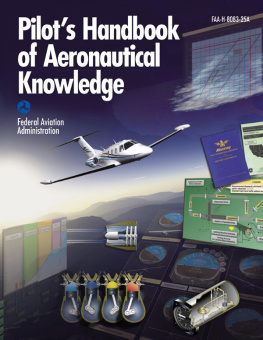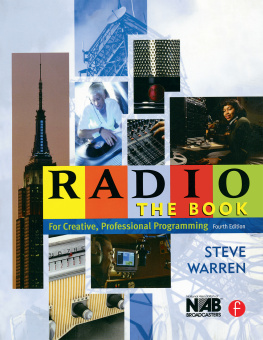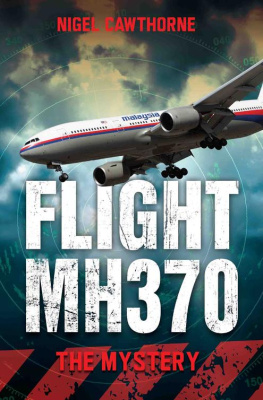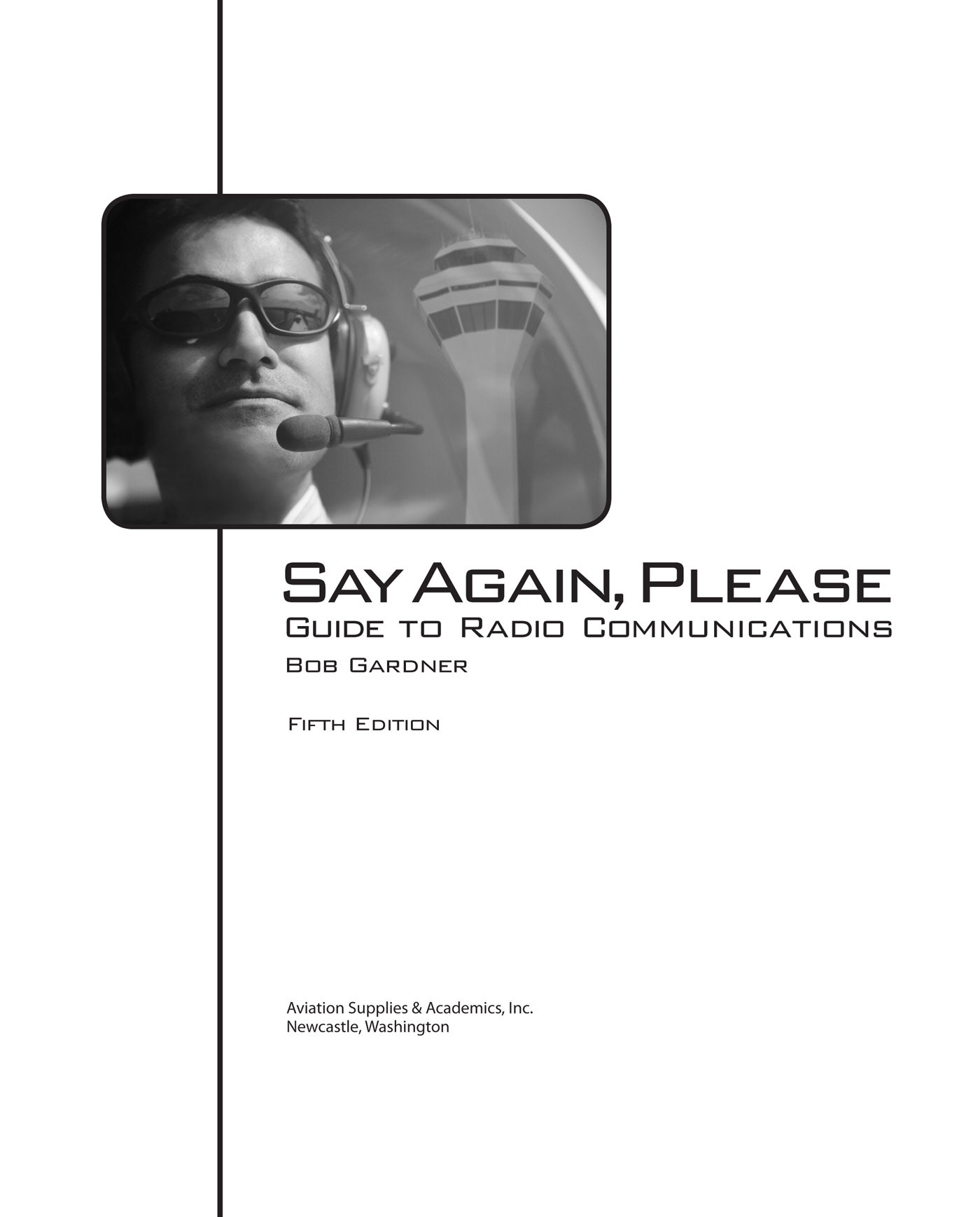Say Again, Please Guide to Radio Communications
Fifth Edition
by Bob Gardner
Aviation Supplies & Academics, Inc.
7005 132nd Place SE
Newcastle, Washington 98059-3153
www.asa2fly.com
19952013 Aviation Supplies & Academics, Inc.
All rights reserved. No part of this publication may be reproduced, stored in a retrieval system, or transmitted in any form or by any means, electronic, mechanical, photocopy, recording or otherwise, without the prior written permission of the copyright holder. While every precaution has been taken in the preparation of this book, the publisher and Bob Gardner assume no responsibility for damages resulting from the use of the information contained herein.
The flight and radio talk examples used throughout this book are for illustration purposes only, and are not meant to reflect all of the possible incidences and communications that may occur in actual flight, nor does the author suggest by using existing facilities that the flight example given covers all possible parameters of an actual flight to or from those facilities. The airport photographs and chart excerpts are not for navigational purposes; refer to the current charts and Airport Facilities Directory when planning your flight.
ASA-SAP-5-EB
ePub ISBN 978-1-61954-090-3
LC# 95-22588
Photo and Illustration Credits: (page numbers refer to print edition) Aerial views of Washington State airports, courtesy Washington State Department of Transportation, Aviation Division; p.viii, Jim Fagiolo; p.2-2, p.2-3, Bendix/King; p.2-4, courtesy Garmin; p.2-5 through 2-12, Telex Communications, Inc.; p.2-10 (top), ASA, Inc.; p.2-10 (bottom), Aloft Technologies; p.2-12 (left), Sigtronics; p.2-13 (top) King Silver Crown; p.2-13 (bottom), Terra; p.2-15, Narco Avionics; p.3-2, 3-4, 3-7, 6-1, 10-3, Bob Gardner; p.3-12, Henry Geijsbeek; p.6-8 Olympia airport guide, courtesy Airguide Publications, Inc. Cover Photos: air traffic control tower, George Clerk/iStockphoto.com; pilot, ColorBlind Images/Blend Images (RF)/Jupiterimages.
About the Author
Bob Gardner has long been an admired member of the aviation community. He began his flying career as a hobby in Alaska in 1960 while in the U.S. Coast Guard.
Bobs shore-duty assignments in the USCG were all electronic/communications based. He served in the Communications Division at Coast Guard Headquarters and was Chief of Communications for the Thirteenth Coast Guard District. He holds a Commercial Radiotelephone Operators license and an Advanced Class Amateur Radio Operators License.
By 1966, Bob accomplished his Private land and sea, Commercial, Instrument, Instructor, CFII and MEL. Over the next 16 years he was an instructor, charter pilot, designated examiner, freight dog and Director of ASA Ground Schools.
Currently, Bob holds an Airline Transport Pilot Certificate with single- and multi-engine land ratings; a CFI certificate with instrument and multi-engine ratings; and a Ground Instructors Certificate with advanced and instrument ratings. In addition, Bob is a Gold Seal Flight Instructor, has been instructing since 1968, and was awarded Flight Instructor of the Year in Washington State. To top off this impressive list of accomplishments, Bob is also a well-known author, journalist and airshow lecturer.
He can be contacted on the Internet at bobmrg@comcast.net.
Books by Bob Gardner:
The Complete Private Pilot
The Complete Private Pilot Syllabus
The Complete Multi-Engine Pilot
The Complete Advanced Pilot
Software and Audio Review by Bob Gardner:
Communications Trainer
Introduction
We live in a technological age. It is possible to fly without radios or electronic aids to navigation and rely solely on the Mark I eyeball, but there is no question that safety is enhanced when pilots can locate one another beyond visual range. The avionics industry continues to provide pilots with improved products which make communication easier and more reliable, but technology alone is not enoughthe user must feel comfortable with the equipment and the system.
We all feel comfortable with the telephone, and an increasing number of pilots feel comfortable with radios that operate in the citizens or amateur radio bands. However, if there is a controller on the other end of the conversation many pilots freeze up. The goal of this book is to increase your comfort level when using an aircraft radio by explaining how the system works and giving examples of typical transmissions.
A brief word of explanation. I am a flight instructor, and flight instructors talk, and talk, and talk. It is impossible for me to shut off my flight instructor instincts and convert myself totally into a writer. You will pick up on this right away because I repeat myself. Over 30 years of instructing I have learned that if something is repeated in different contexts it will be remembered, so you can count on the same information showing up in more than one chapter. That is not sloppy editing or carelessness, it is good instructional technique. Also, some types of airspace change classification when the tower closes down or the weather observer goes homethere will be some overlap as I discuss each situation in the chapter on each type of airspace.
Conventions
I will not spell out numbers in this text; the AIM says that numerals are to be pronounced individually: 300 is spoken as three zero zero, runway 13 as runway one three, etc. I know that I can count on you to make the mental conversion. Altitudes are handled differently, as you will learn in Chapter 3. Also, controllers do not say degrees when assigning courses and headings, so neither will I.
In radio communication, the different classes of airspace are spoken as their phonetic equivalents (again, see Chapter 3), without the word class:
Cessna 1357X is cleared to enter the Charlie surface area
In the text, however, they will be referred to as Class B, Class G, etc.
Editors Note
The examples of radio talk between pilots, controllers and other communications facilities in this text are printed in a bold and italics, non-serif typeface. These are also identified by small labels, which are sometimes abbreviated, as visual aids to the reader to show who is talking. Definitions for these labels can be found in Appendix A, Communications Facilities.
Example:
PILOT Cessna 1357X requests runway 23.
Acknowledgements
The author wishes to acknowledge the assistance of the following experts in reviewing the text for accuracy and completeness:
Suzanne Alexander, Manager, Boeing Field Tower
Jim Davis, Plans and Procedures, Seattle-Tacoma TRACON
Terry Hall, American Avionics, Seattle
Mike Ogami, Seattle Automated Flight Service Station
Note about the examples used in this book:
The National Aeronautics and Space Administration (NASA) commissions contractors to search the NASA database for lessons to be learned from accidents and pilot reports. Also, NASA publishes Callback, a free monthly newsletter that provides its subscribers with selected incidents from the Aviation Safety Reporting System (ASRS). Except for those few cases where I received an anecdote directly from an ATC controller, the examples in this book come from NASA sources.
If you want to receive Callback, simply send your address to ASRS, Box 189, Moffett Field, California, 94035 or view online at:

















